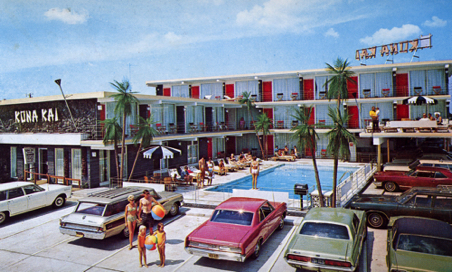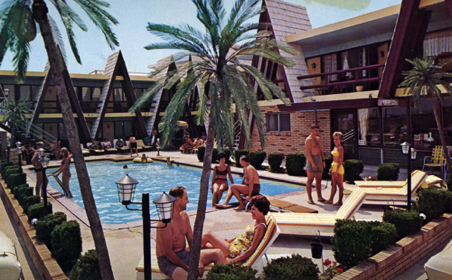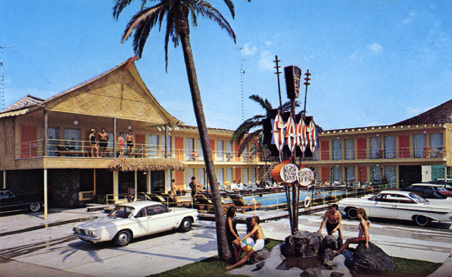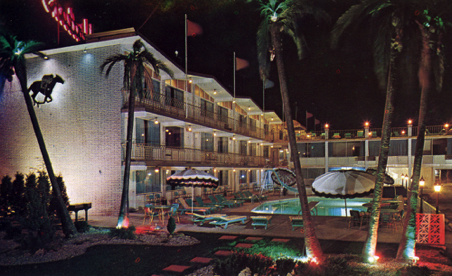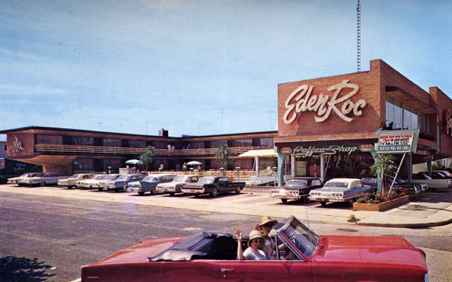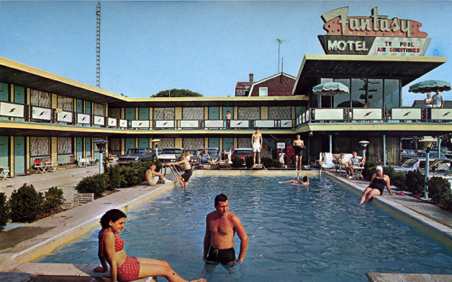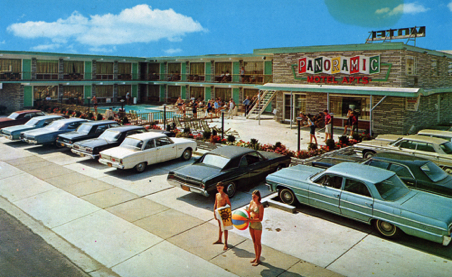TEARS AND ZONING IN NEW JERSEY
or Goodbye Doo-Wop, Hello Change
: : “Youth is truth they say
And old is rolled away
Grey is shown the door
While youth just paints the floor
With many colors
Bright and rainbow colors
Brand new, special and unique
Bring the new, replace the antique” : :
Stan Ridgway
: : I’ve been fascinated with the New Jersey shore communities of Wildwood, North Wildwood and—especially—Wildwood Crest, for different reasons over the course of my 40 years. At various times in my life, going to the Wildwoods has been all about the beach and the boardwalk and the t-shirt and novelty shops… waterslides and ice cream parlors… eating at a different Italian restaurant every night… smuggling hermit crabs back across the Canadian border as souvenirs of my trip… In other words: summer vacation. : :
: : I returned to Wildwood Crest in 1999, after an absence of over 20 years. I was in my mid-thirties and the Wildwoods had not changed all that much. Returning often over the past 6 years, my recent trips to the Crest were now all about time travel… But the truth is, going to the Wildwoods was always like going on a trip to 1962. : :
: : The Wildwoods, for the most part, still contain a large and very well-preserved collection of mid-20th century commercial—especially motel—architecture. Low rise post-and-beam buildings with exaggerated angles, porte-cochères, glass walled lobbies, cantilevered decks, space-age lighting fixtures, and often, spectacular neon signs jutting out above the rooflines. : :
: : Now, in case you’ve missed it, there has been an increased appreciation of mid-20th century architecture and design over the past few years and therefore, not surprisingly, the Wildwoods and their architecture (often referred to with the recently coined term “Doo Wop”) have become something of a hotspot for so-called “archi-tourists.” : :
: : But the Wildwoods are beginning to change… and the change is happening much quicker than one would imagine for a place that remained untouched by time for as long as it has. : :
: : I guess the answer to why the Wildwoods’ architectural landscape remained unchanged for so long is simple: economics. Beginning in the late 1970s and through the Reagan years, the Wildwoods’ popularity seemed to wane with folks like us, that is, Canadians and others coming to the island from great distances. During the lean recession years, Wildwood motels could always get by and survive even on a somewhat diminished crowd of “regulars”—folks from New Jersey, New York, Philadelphia and other areas close by—who’d been going there for years. But for us, who came to the island from farther away, the Wildwoods were no longer often considered as a vacation destination. Less people spending less money meant less opportunity for motel owners to renovate, update or bring their motels up to current resort standards. So maybe motels would get a fresh coat of paint each season but major upgrades were out of the question. With the economy the way it was in the 80s, there was also no way to justify tearing down and replacing the buildings. In fact, even today—in an era of resurging popularity in the Wildwoods—owners of vintage motels have told me that though they make enough money to maintain their establishments in a typical (but relatively short) beach season that is really only 3 or 4 months long at most, it’s not quite enough to restore them to what they could be—with new plumbing and electrical systems, bigger rooms, new furniture and modern amenities—all the while respecting mid-century design guidelines. : :
: : So, thankfully, some old motels and their neon signs have stayed put. : :
: : But today, unfortunately, some of the same forces that have helped increase interest in the Wildwoods’ mid-century heritage may also be seen as having initiated the change that is threatening exactly those aspects of the Wildwoods they hoped to preserve. : :
: : Wildwoods’ Doo Wop Preservation League got the ball rolling, doing a great job of increasing awareness of all that the Wildwoods had to offer not only in terms of architecture but of mid-century pop culture in general. But despite this, some of their efforts sometimes seem a little misguided, with the endorsement of projects and concepts that threaten to turn the Wildwoods into something of a 1950s theme park, rather than preserve their authentic vintage character. : :
: : Perhaps the DWPL should look to the type of preservation efforts taking place in cities like Palm Springs, California, where more emphasis has been placed on architecture and design features rather than on 1950s “rock ‘n roll” culture. I have yet to see any architect’s name mentioned in articles about vintage Wildwood but if you want to learn that Chubby Checker introduced “The Twist” to the world in a Wildwood nightclub, the information is out there and readily available. True, the blue-collar Wildwoods were never upscale Palm Springs but preserving the towns’ architectural character may necessitate adopting more of a Palm Springs-like attitude to attract crowds that are genuinely interested in preservation, rather than folks looking to have supper in a revamped diner while listening to “Rock Around the Clock” in heavy rotation on the jukebox. : :
: : With the DWPL spreading the word, it didn’t take long for the media to jump on the Wildwoods bandwagon. Articles began to appear in publications both near and far. In fact, an article in my local paper in Montreal is what piqued my interest and got me thinking about making a return to the Jersey shore. : :
: : With the media reaching out to potential visitors across the continent (well, up and down the east coast, at least), vacationers started coming back to the Wildwoods in droves by the mid-1990s. But just as some preservation-minded motel owners began making real money again and could start thinking about upgrading their facilities, others were also taking notice of the Wildwoods’ popularity… Developers began to realize that renewed interest in the Wildwoods meant that there was money to be made on the island. In the developers’ eyes, the Wildwoods had potential and were ready for an overhaul. : :
: : It is not at all surprising that developers have no interest in preservation. The bottom line is money. Rather than restore old motels, it’s cheaper to raze them and put up new cookie-cutter condos that feature modern amenities and more square footage—which translate to “more money.” : :
: : Motel owners often can’t be blamed for selling to developers either. For the most part, these people are not preservationists, they are business people. Sure, it’s sad that there aren’t more of them who have taken an interest in the “Doo Wop” movement but many proprietors, especially long-time owners who have lived through some difficult business years, are being asked by developers to “name their price” which can often represent their retirement fund or their kids’ college tuition. Most of these people cannot be considered “sell outs”—in fact, they probably would have stayed put but they have been swayed by developers who made them offers they could not refuse. : :
: : While it has been a shock to see certain old motels being sold, torn down and replaced with non-descript condos, in some cases, it’s not surprising that motels have met with the wrecking ball, as several of them have begun to show their age. In addition to plumbing and electrical problems, some—including a few recently demolished Wildwood Crest motels—had begun to experience structural problems. : :
: : A few long-time motel owners who were close to being swayed—not by developers but by preservationists—faced another problem. They equated “going historic”—that is, preserving their motel’s vintage character according to standards set by preservationist groups—with giving up part of the control of their own business: being told what kind or color of paint to buy and what kind of renovations to make, without any financial contribution from those making the suggestions. : :
: : So the ownership of many of the Wildwoods’ mid-century motels has changed hands over the past few years. Unfortunately, most motels went to developers who simply tore them down. : :
: : Other than the motels that have remained in their current state, there have been a few that have received “Doo Wop makeovers”—made possible through outside investment, such as new owners with new capital or established corporations who purchase with no plans to demolish. While this has resulted in some spectacular renovations, it has also, in some cases, led to the emergence of an unfortunate trend, sometimes referred to as “neo-Doo Wop,” which involves, not the preservation of authentic mid-century architecture, but the erecting of “Happy Days”-themed, Doo Wop-inspired motels and other establishments. The results are often just as bad as replacing an old motel with a 4 storey, 12-plex condo block. : :
: : In the last two years, the old motels have continued to fall at an alarming rate… especially in Wildwood Crest, where some owners of vintage motels have expressed feeling a little bit strange about staying when, all around them, new condos are going up. They see the situation as being similar to that of the little old lady in Atlantic City who refused sell her house, only to have it engulfed by an enormous casino that was built around it. : :
: : The situation is complicated. So much has changed in the last few years that even the new condominium market on the island is becoming over-saturated, with new, expensive condos becoming harder and harder to sell. Replacing motel rooms with condos that remain unsold and vacant will soon prove to be detrimental to the towns’ welfare. : :
: : There are reports that city officials and planning boards are warming to the idea of adopting new zoning and design guideline standards that would encourage motel preservation, and provide incentives to do so. Whatever the outcome, the reality is that a part of the Wildwoods’ mid-20th century legacy has already been lost. : :
: : No matter what comes up in city planning meetings or is proposed by preservationist groups, some motel owners seem to think that there is already a master plan in place—for Wildwood Crest at least—and nothing can be done to change it. Motels on the east side of Ocean Avenue will remain—most are not classic, L-shaped, low rise motels but are larger 4, 5 or 6 storey vintage motels that are nonetheless considered “Doo Wop.“ On the west side of Ocean Avenue (that is, across the street from the beach), the smaller, low rise motels that give the Wildwoods their open-air feel will continue to fall and be replaced by new condos… : :
: : So how does the Wildwoods’ story end? Well, it isn’t over yet… Changes are still taking place as I write this… Good folks are still fighting the good fight to preserve what remains of the Wildwoods’ mid-century heritage. But how does it end for me? Do I continue to make semi-regular trips to the area, watching as part of what made the Wildwoods so fascinating to me continues to fade away? Or do I content myself in living with memories, reminiscing about the ghosts of a neon past? : :
: : As of the beginning of October 2005, the list of motels coming down or rumored to be demolished before next season includes the following: Hawaii Kai, Silver Beach, Thunderbird, Palm Crest, 24th Street, Oceanic, Bel Air, Beach Colony, Aqua Beach, Tangiers, Yankee Clipper, Buccaneer, Hi Lili, Kona Kai, Binns, Bonito, Flame Inn, Kings Inn, Mary Ann, Monaco, New England, Surfside 7, Lu Fran, Starfire, Windward, Lurae, Sand Dollar, Eden Roc, Sana Souci, Donaraile… : :
John Trivisonno © 2005
UPDATE: SAD NEWS - Monday, January 9, 2006
Proof of the destruction and loss of many of the Wildwoods' mid-century motels: our beloved Kona Kai (Mai Tai's home base in the Wildwoods) went down earlier this week... It seems someone saved the neon sign, at least.
CLICK TO ENLARGE PHOTOS (from a circa early 1970s Wildwood tourist guide)

